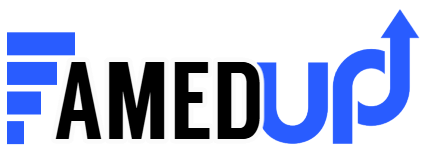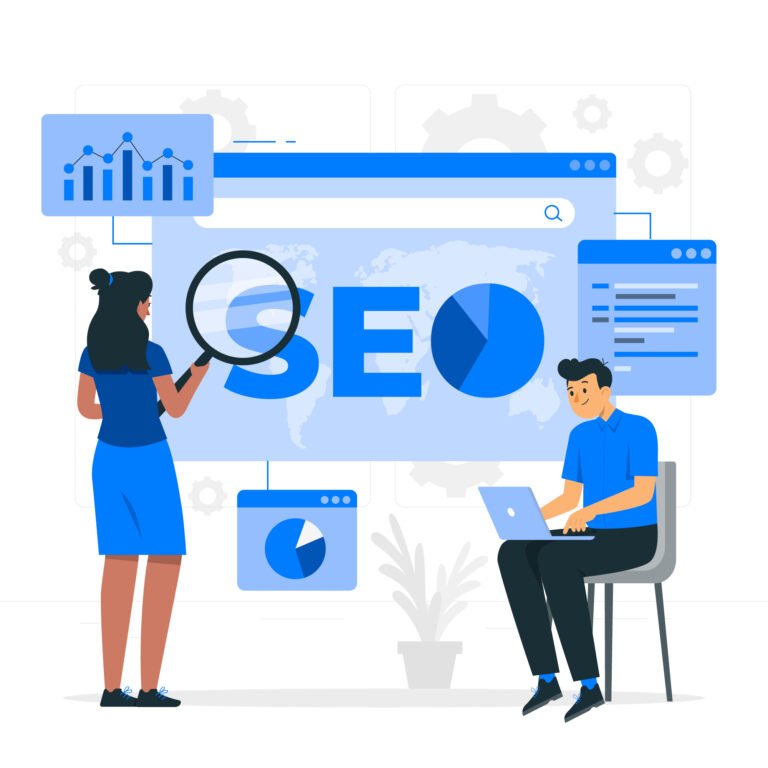What This Guide Covers
If you’re new to the world of digital marketing, you’ve probably heard the term SEO thrown around a lot — but what exactly does it mean, and why is it so important?

This guide is designed to walk you through the fundamentals of Search Engine Optimization (SEO). We’ll break down what SEO is, how it works, the different types of SEO, and why it plays such a crucial role in online success. Whether you’re a small business owner, an online store operator, or just starting your journey in digital marketing, this guide will help you understand the basics and give you actionable steps to improve your website’s visibility.
Why SEO Matters in 2025
In 2025, the digital landscape is more competitive than ever. With millions of websites competing for attention, simply having an online presence isn’t enough — you need to be visible. That’s where SEO comes in.
Search engines remain the top source of traffic for most websites. When done right, SEO helps you rank higher in search results, which means more visibility, more clicks, and more opportunities to convert visitors into customers.
With evolving algorithms, AI-generated content, voice search, and mobile-first indexing, staying on top of SEO trends has never been more critical. Businesses that invest in SEO today are setting themselves up for long-term growth and sustained online authority.
1. What is SEO?
Definition of SEO
SEO (Search Engine Optimization) is the process of improving your website’s visibility in search engine results pages (SERPs) like Google, Bing, and Yahoo. The higher your site ranks for relevant keywords, the more likely users are to click and visit your website.
In simple terms, SEO is all about making your website search-engine friendly so that it appears when people are looking for the products, services, or information you offer.
The Goal of SEO: Visibility and Traffic
The main goal of SEO is to increase organic (non-paid) traffic to your website. When your content appears at the top of search results, it gets more exposure — which leads to more visitors, leads, and sales.
Unlike paid ads that stop driving traffic when your budget runs out, SEO delivers long-term results by helping your site earn its place naturally through relevance and authority.
How Search Engines Work (Brief Overview)
Search engines like Google use automated programs called crawlers or bots to scan the web. These bots crawl web pages, index their content, and determine how relevant each page is to a user’s search query.
Here’s a quick look at how it works:
- Crawling – Bots discover new and updated pages.
- Indexing – Pages are stored and analyzed in a massive database.
- Ranking – Algorithms determine which pages appear in what order based on hundreds of ranking factors.
SEO helps search engines understand your content and decide whether it’s worthy of a top position in search results.
2. Types of SEO
SEO isn’t a one-size-fits-all strategy — it includes several components that work together to improve your website’s performance. Understanding the different types of SEO helps you build a balanced and effective optimization plan.
On-Page SEO
On-page SEO refers to everything you can control directly on your website to improve its search rankings.
Key elements include:
- Keyword Optimization: Using relevant keywords naturally in your titles, headings, and content.
- Meta Tags: Writing compelling title tags and meta descriptions to improve click-through rates.
- Content Quality: Creating valuable, original, and engaging content for your visitors.
- Internal Linking: Linking to other relevant pages on your site to improve navigation and SEO structure.
Off-Page SEO
Off-page SEO focuses on building your website’s reputation and authority through actions taken outside your own website.
Important techniques:
- Backlink Building: Getting other reputable sites to link to your content.
- Social Sharing: Promoting content on platforms like Twitter, LinkedIn, or Reddit to gain exposure.
- Influencer Outreach: Collaborating with industry influencers to boost brand awareness and credibility.
Technical SEO
Technical SEO ensures that your website meets the technical requirements of search engines so they can crawl and index it effectively.
Key areas include:
- Site Speed: Optimizing images, code, and server performance for fast loading.
- Mobile-Friendliness: Ensuring your website is responsive and performs well on all devices.
- Secure Connection (HTTPS): Using SSL to protect your site and earn trust.
- XML Sitemaps and Robots.txt: Helping search engines understand which pages to crawl and index.
Local SEO
Local SEO is essential if you serve customers in a specific area or run a physical business.
Key tactics:
- Google My Business: Creating and optimizing your GMB listing.
- Local Keywords: Using terms like “near me” or including your city/region in your content.
- Online Reviews: Encouraging positive reviews on platforms like Google and Yelp.
3. Why SEO is Important
In today’s competitive digital world, having a website isn’t enough — your potential customers need to be able to find it. That’s where SEO plays a critical role.
Organic vs Paid Traffic
There are two main ways to bring visitors to your website:
- Paid traffic, which comes from advertising (like Google Ads or social media ads).
- Organic traffic, which comes from unpaid search results.
While paid traffic gives immediate results, organic traffic is more sustainable and cost-effective in the long run. SEO focuses on improving your organic visibility so that your website continues to attract visitors even when you’re not spending money on ads.
Trust and Credibility
Users trust search engines — and the higher your site ranks, the more credible you appear. A well-optimized site with helpful content, fast loading times, and secure browsing signals to both users and search engines that your business is professional, reliable, and relevant.
High-ranking pages are often seen as more trustworthy, which leads to better brand perception and higher click-through rates.
Long-Term Marketing Investment
Unlike paid ads, which stop generating traffic the moment you stop paying, SEO is a long-term investment. Quality SEO efforts continue to pay off for months or even years.
When done correctly, SEO can:
- Deliver consistent traffic and leads
- Lower your customer acquisition costs
- Build a strong online foundation for your brand
4. How Search Engines Rank Pages
To get your website on the first page of Google or any search engine, it’s important to understand how pages are ranked. Search engines use complex algorithms to evaluate and rank millions of web pages in real time.
Crawling and Indexing
Before a website can appear in search results, search engines must first discover and understand its content.
- Crawling: This is the process where search engine bots (also called spiders) scan the internet and visit websites.
- Indexing: Once a site is crawled, the content is stored in a massive database (the index), where it’s organized and categorized.
If your website isn’t being crawled or indexed, it won’t appear in search results — no matter how good your content is.
Ranking Factors (Google’s Algorithm Basics)
Once your site is indexed, Google’s algorithm decides where it should appear in search results based on hundreds of ranking signals. Some of the most important include:
- Relevance: How well your content matches the search query.
- Content Quality: Original, valuable, and well-written content ranks better.
- Backlinks: High-quality links from other websites improve your authority.
- Page Experience: Mobile-friendliness, page speed, and usability all affect rankings.
- Keyword Usage: Proper use of keywords in titles, headers, and body content.
Search engines want to provide the best possible answer to each query, so the more useful and trustworthy your content is, the higher it will rank.
User Intent and Relevance
Modern SEO isn’t just about keywords — it’s about understanding what users are really looking for.
For example:
- Someone searching “best budget camera 2025” wants product comparisons or reviews.
- Someone searching “how to use Instagram reels” wants a tutorial or guide.
This is known as search intent — and content that directly satisfies the user’s intent is more likely to rank well. Matching content to intent is now essential for SEO success.
5. SEO Best Practices for Beginners
If you’re just starting with SEO, it can seem overwhelming — but don’t worry. By following a few proven best practices, you can begin improving your site’s visibility and ranking in search engines.
Keyword Research 101
Keyword research is the foundation of any good SEO strategy. It involves finding the words and phrases your target audience is typing into search engines.
Tips for beginners:
- Use tools like Google Keyword Planner, Ubersuggest, or Ahrefs.
- Focus on long-tail keywords (e.g., “best running shoes for flat feet”) — they’re less competitive and more targeted.
- Understand search intent behind the keywords.
Writing SEO-Friendly Content
Creating quality content that both users and search engines love is key.
Here’s how:
- Use your primary keyword naturally in the title, URL, headings, and first paragraph.
- Break content into sections with H2 and H3 subheadings.
- Write clearly, and focus on solving problems or answering questions.
- Add multimedia (images, videos, charts) to enhance value.
Optimizing Titles and Meta Descriptions
Your title tag and meta description are the first things users see in search results. Make them count.
Best practices:
- Keep titles under 60 characters, and include your main keyword.
- Write compelling meta descriptions (under 160 characters) that encourage clicks.
- Make sure each page has a unique title and description.
Internal Linking
Internal links connect your pages and help search engines understand your site structure.
Benefits of internal linking:
- Distributes page authority (link juice).
- Keeps visitors on your site longer.
- Improves crawlability and indexing.
Example: If you’re writing about SEO tools, you could link to another blog post like “Top Free SEO Tools in 2025.”
6. Common SEO Mistakes to Avoid
Even with the best intentions, beginners often make SEO errors that can hurt their rankings or slow their progress. Avoiding these common pitfalls can give your site a much better chance of succeeding.
Keyword Stuffing
One of the oldest and most harmful mistakes is keyword stuffing — overloading your content with keywords in an unnatural way.
❌ Bad example:
“Buy Instagram followers now. Our Instagram followers are the best Instagram followers online.”
✅ Good example:
“Our service helps you grow your Instagram following organically, with real, active users.”
Instead, use keywords strategically and naturally throughout your content.
Ignoring Mobile Optimization
In 2025, mobile-first indexing is standard. If your website isn’t optimized for mobile devices, you’re losing rankings and users.
Key tips:
- Use a responsive design.
- Ensure text is readable without zooming.
- Make buttons and menus touch-friendly.
Duplicate Content
Search engines penalize websites that publish the same content on multiple pages.
Avoid:
- Copying content from other websites
- Creating multiple pages targeting the same keyword with nearly identical content
Always aim for unique, high-value content on each page.
Buying Low-Quality Backlinks
Backlinks are important, but quality matters more than quantity. Buying backlinks from shady sources or spammy directories can hurt your rankings — or get your site penalized.
Instead:
- Earn links naturally by creating valuable content.
- Reach out to reputable blogs or websites for guest posting opportunities.
- Build relationships in your industry to earn authentic mentions.
7. SEO Tools to Get Started
You don’t need to be an expert to start doing SEO — but using the right tools can make your job a lot easier. Whether you’re tracking performance, doing keyword research, or analyzing competitors, these tools can help you grow faster.
Google Search Console
Google Search Console is a free tool from Google that helps you monitor how your site performs in search.
You can use it to:
- See which keywords bring traffic
- Submit sitemaps and check indexing status
- Identify crawl errors and mobile usability issues
- Track your site’s performance over time
Google Analytics
Google Analytics shows you who’s visiting your site, how they found it, and what they’re doing once they arrive.
With it, you can:
- Measure traffic sources (organic, social, referral)
- Track bounce rates and time on site
- Understand user behavior
- Set goals for conversions and sales
Ubersuggest / Ahrefs / SEMrush
These are powerful all-in-one SEO platforms that help you research keywords, analyze competitors, and audit your website.
Common features:
- Keyword research & volume analysis
- Backlink tracking
- Site audits
- Rank tracking
Ubersuggest is beginner-friendly and has a generous free plan, while Ahrefs and SEMrush are more advanced and used by professionals.
Yoast SEO (for WordPress users)
If your website is built with WordPress, the Yoast SEO plugin is an essential tool.
Benefits:
- Helps you optimize each page and post for SEO
- Analyzes readability and keyword usage
- Automatically generates sitemaps
- Manages meta titles and descriptions
8. How Long Does SEO Take to Show Results?
One of the most common questions beginners ask is:
“How long before I see results from SEO?”
The short answer? It depends.
Short-Term vs Long-Term Expectations
SEO is not a quick fix — it’s a long-term strategy. While some changes (like fixing broken links or adding meta tags) might show small improvements in a few weeks, most SEO efforts take 3 to 6 months to deliver noticeable results, and 6 to 12 months for more competitive keywords.
Factors that influence how quickly you see results include:
- Domain age and authority
- Competition in your niche
- Quality of content
- Technical health of your website
- Consistency in publishing and optimizing
What You Can Expect Over Time
Here’s a rough timeline of typical SEO progress:
- 0–3 Months: Setup, audits, keyword research, and fixing technical issues
- 3–6 Months: Start seeing gradual traffic increases, especially from long-tail keywords
- 6–12 Months: Higher rankings, more backlinks, stronger domain authority
- 12+ Months: Competing for top positions, scaling content, consistent organic traffic
SEO is like planting seeds. With the right care and strategy, it will grow into a valuable and sustainable source of traffic over time.
Conclusion
SEO may seem complex at first, but once you understand the basics and follow proven best practices, it becomes a powerful tool to grow your online presence.
Whether you’re running a social media marketing service, an eCommerce site, or a personal blog, SEO can help you:
- Increase your website’s visibility
- Attract more organic traffic
- Build trust and authority in your niche
- Generate long-term growth without relying only on paid ads
Remember, successful SEO doesn’t happen overnight — it’s a consistent, ongoing process. Start small, stay focused on your audience’s needs, and keep optimizing as you learn.
Your Next Steps
- Do keyword research for your niche.
- Optimize one page of your site using on-page SEO best practices.
- Set up Google Search Console and Google Analytics.
- Keep learning and stay updated with SEO trends.
If you stay patient and persistent, your SEO efforts will pay off — and your website will be one step closer to the top of Google.
Read Also: How to Do Keyword Research Like a Pro (Step-by-Step)


